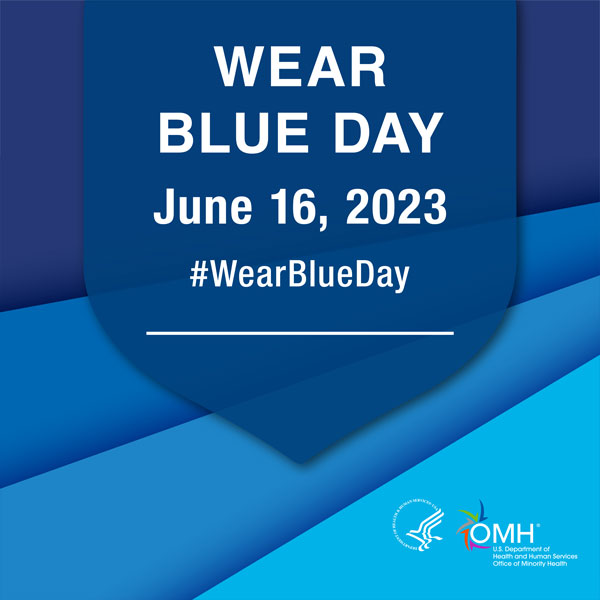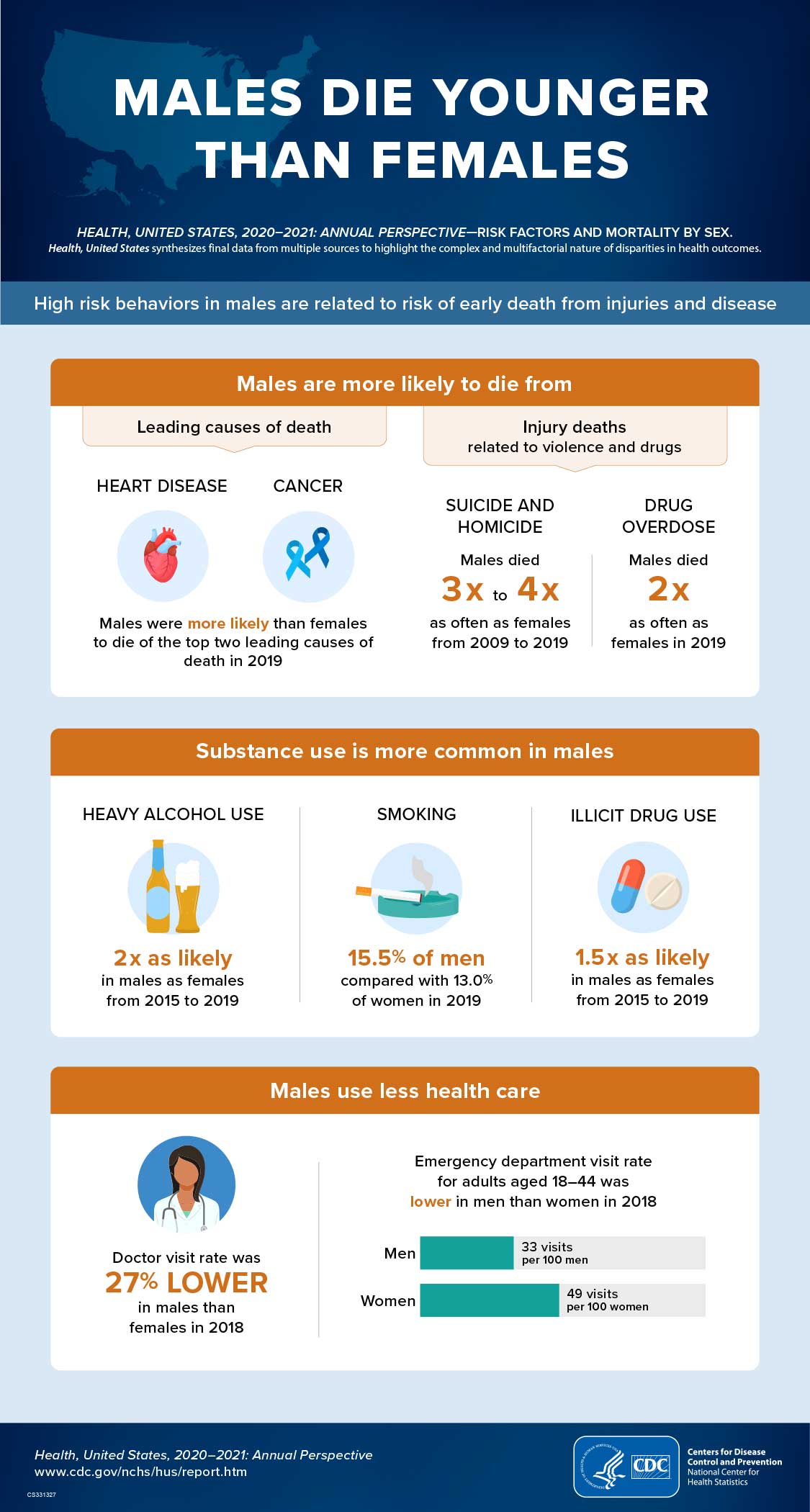Throughout June, Men’s Health Month aims to encourage boys and men to take charge of their overall health by implementing healthy living decisions.
In general, men in the U.S. are expected to live nearly six years less than women, and non-Hispanic Black and American Indian/Alaska Native men have a lower life expectancy than non-Hispanic white men. Many diseases that disproportionately impact men, like heart disease and cancer, are preventable through regular doctor’s visits and healthy lifestyle choices. However, one survey found that 63 percent of men of color report not getting regular health screenings. Men are also more likely to have lower health literacy levels than women, meaning they may struggle to find, understand, and use information and services required to make informed decisions about their health.
Men’s Health Fast Stats
The Centers for Disease Control and Prevention (CDC) reports that the leading causes of death for men in 2021 were heart disease, cancer, and COVID-19. They also report a number of additional statistics about men’s health, including:
- Percent of men aged 18 and over in fair or poor health: 13.2% (2021)
- Percent of men aged 18 and over who had five or more drinks in 1 day at least once in the past year: 30.9%
- Percent of men aged 18 and over who met the 2018 federal physical activity guidelines for aerobic and muscle-strengthening activity: 28.3%
- Percent of men aged 18 and over who currently smoke cigarettes: 13.1% (2021)
- Percent of men aged 20 and over with obesity: 40.5% (2015-2018)
- Percent of men aged 20 and over with hypertension (measured high blood pressure and/or taking anti-hypertensive medication): 51.9% (2015-2018)
- Percent of males under age 65 without health insurance coverage: 11.5%
The U.S. Department of Health and Human Services (HHS) reports that:
- According to a 2022 survey, Asian American, Native Hawaiian, and Pacific Islander men were less likely to experience good communication with their doctor than men from other racial and/or ethnic backgrounds.
- In 2021, American Indian/Alaska Native men had a 47 percent higher incidence of death than non-Hispanic white men; Black men had a 26 percent higher incidence of death.
- According to one survey Exit Disclaimer, 49 percent of Hispanic/Latino men have difficulty understanding the process of getting medical care.
The HHS Office of Minority Health Knowledge Center has released a bibliography and important insights regarding racial and ethnic minority boys and men. This brief bibliography contains a variety of resources focused on health literacy, barriers to healthcare, and improving healthcare access for racial and ethnic minority boys and men. The list contains three sections: fact sheets and toolkits for consumers, reports for professionals, and peer-reviewed journal articles. You can view the list here.
Health Literacy
According to CDC and reinforced in the National Healthy People 2030 initiative, health literacy includes both personal and organizational elements:
- Personal health literacy entails an individual’s ability to find, understand, and use information and services to make informed health-related decisions and take deliberate actions for themselves and others.
- Organizational health literacy focuses on an organization enabling individuals to find, understand, and use information and services to inform health-related decisions and take deliberate actions for themselves and others.
- Racial and ethnic minority groups, including boys and men, have the lowest health literacy levels, and these groups also experience a disproportionate burden of disease. Therefore, it is important to find ways to improve their access, understanding, and use of health information to achieve better health outcomes.
Health Status
In the United States, racial and ethnic minority men experience poor health because of their race, ethnicity, gender identity, and social determinants of health (non-medical factors that influence health outcomes); thus, it is important to promote men’s health equity. According to the 2021 CDC National Vital Statistics data, the death rate for men was 1,118.2 per 100,000 men, with heart disease, cancer, and COVID-19 documented as the three leading causes of death.
- According to the CDC National Center for Health Statistics, 13.2 percent of all men aged 18 and over reported fair or poor health in 2021 compared to 13.9 percent of women. Men are challenged with preventable conditions including obesity, high blood pressure or hypertension, and are also burdened by prostate cancer.
- According to the CDC, from 2015-2018, 40.5 percent of men aged 20 and over were overweight or obese and 51.9 had high blood pressure.
- According to the National Cancer Institute 2016-2020 data, non-Hispanic black men are 65 percent more likely to have prostate cancer than non-Hispanic white men, and twice as likely to die from it.
Barriers to Healthcare and Improving Healthcare Access
Considering the healthcare access barriers (stigma as it relates to mental healthcare, lack of treatment knowledge, systemic racism, and less than normal frequency of healthcare seeking behavior, especially among black men) culturally responsive health promotion is recommended using a cohort model, such as engaging family members, friends, and community members/community organizations. This strategy can help to increase disease knowledge, motivate men to seek care more frequently, and provide social support to improve health outcomes for racial and ethnic minority boys and men and achieve health equity.

On #WearBlueDay we join @minorityhealth in raising awareness of the health disparities experienced by racial and ethnic minority boys and men. Learn how we can improve their health outcomes by visiting their site. #MHM2023 #MensHealth #BoysHealth #MinorityHealth #HealthEquity #CLAS
Making Progress
The Wellness Coalition has been engaging minority communities throughout the River Region to gain insight to develop strategies that improve access to healthcare. Our recent Tour of Wellness events in Montgomery and Tuskegee provided nearly 200 attendees with access to a robust list of low- or no-cost wellness services, and connected them with up to twenty agencies of support. Additionally, COVID-19 vaccines and boosters were provided, and a welcome space was created for men to talk about health-related issues they were experiencing.
The key to our success with these events is the involvement of community businesses, healthcare providers, and decision-makers. If you or your practice or business are ready to help break down barriers to healthcare access, call The Wellness Coalition at (334) 293-6502 to get involved today. Do it for the men in your life.

